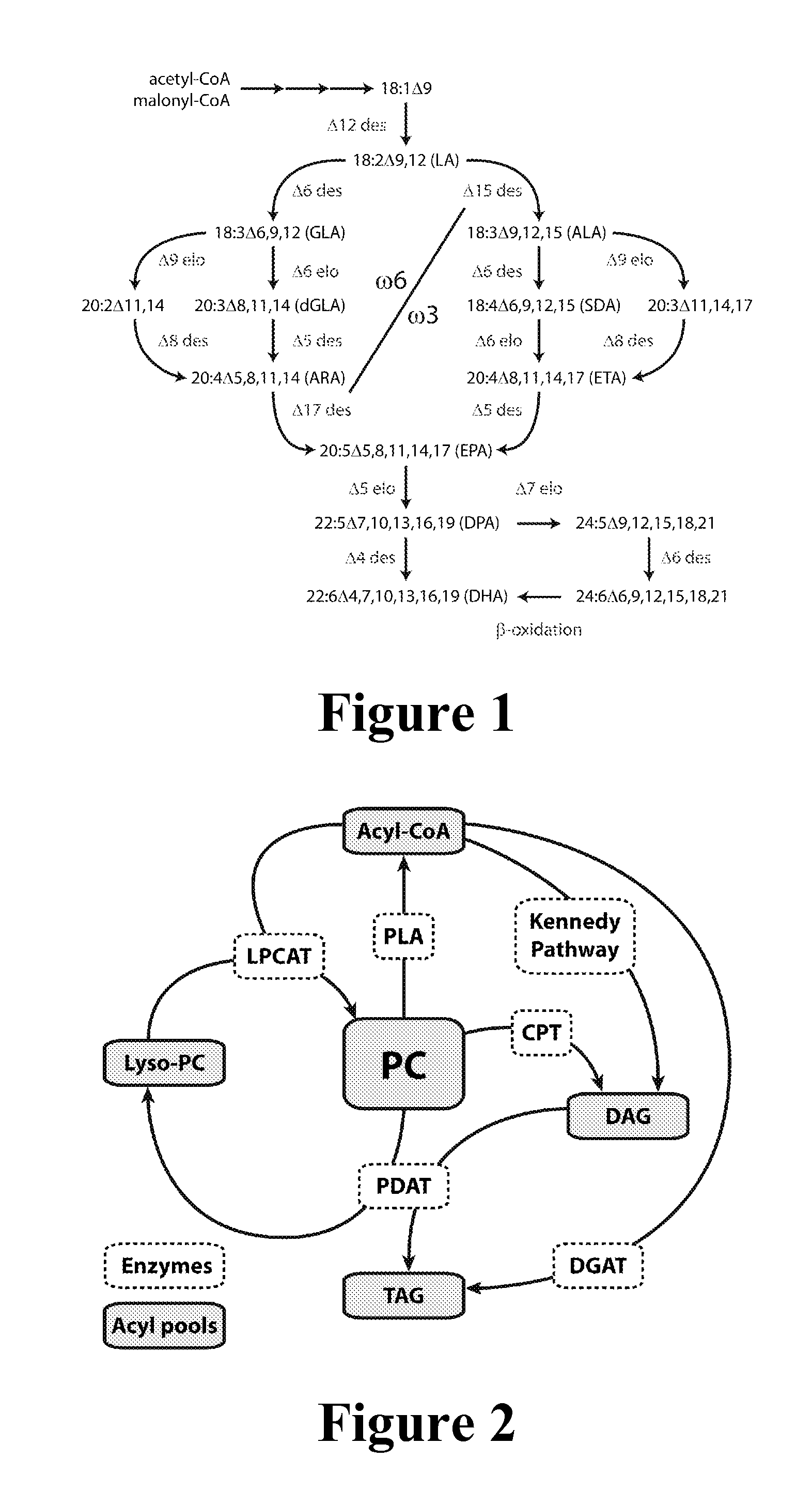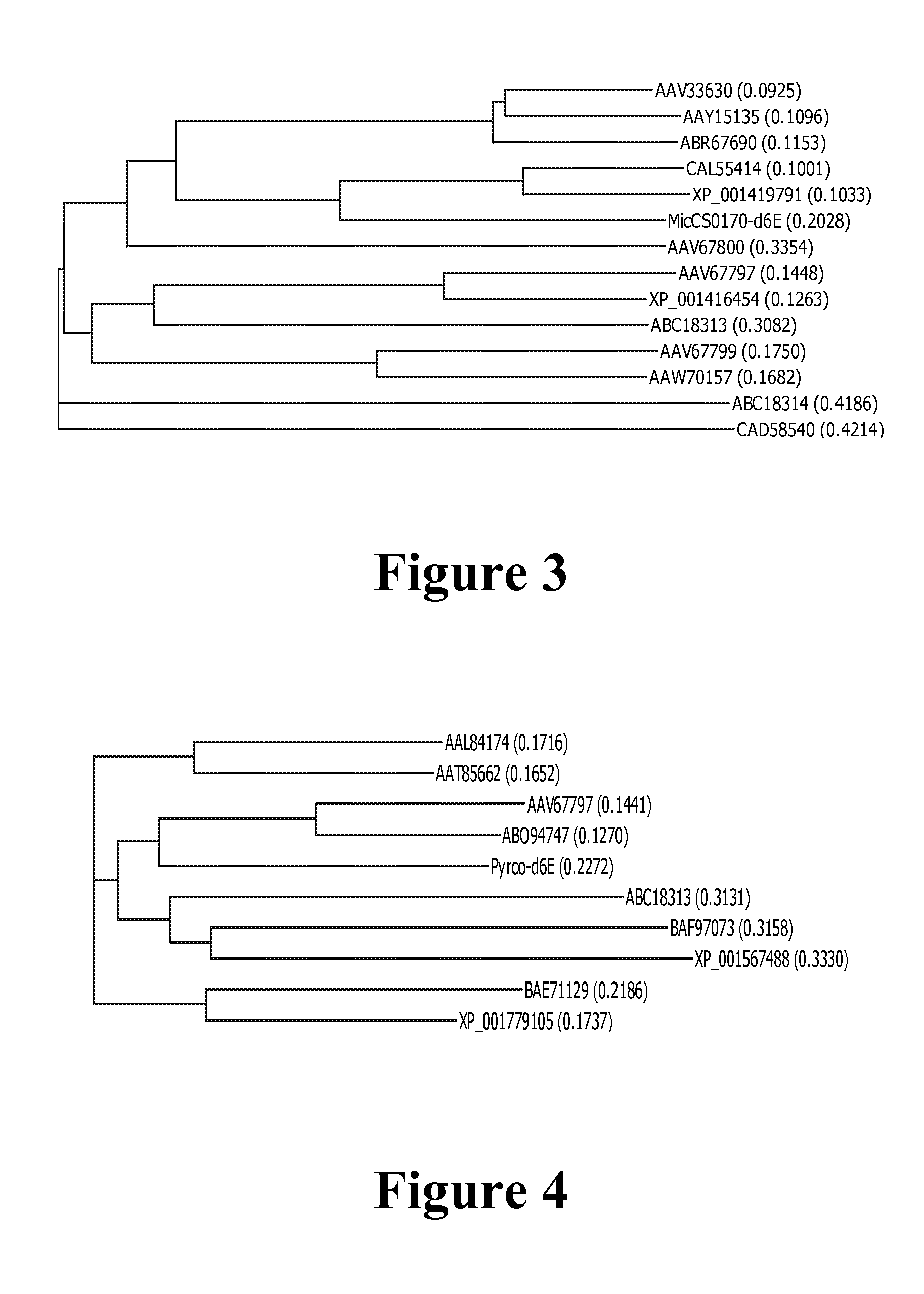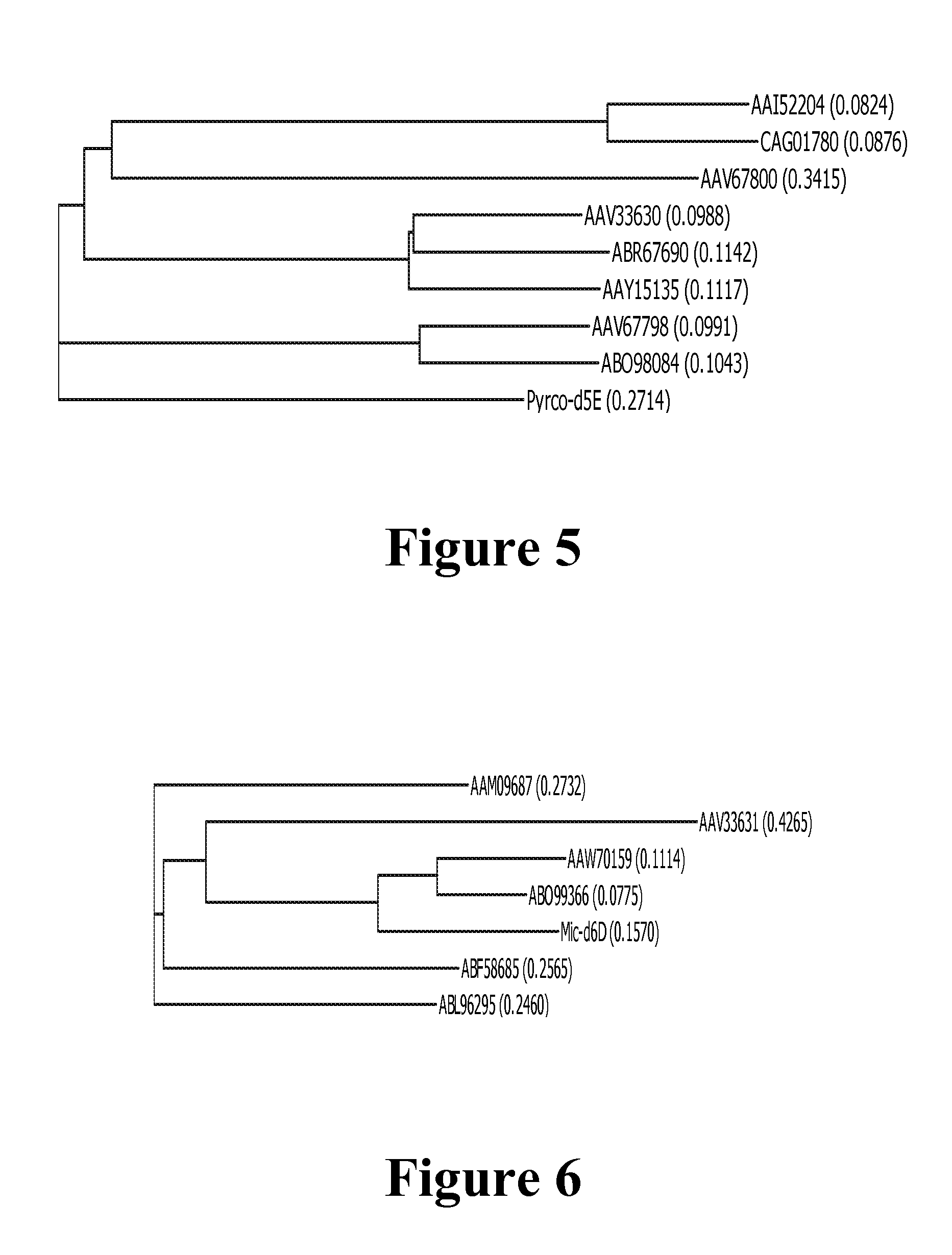Enzymes and methods for producing omega-3 fatty acids
a technology of enzyms and methods, applied in the field of synthesizing long-chain polyunsaturated fatty acids, can solve the problems of imbalanced diet of most modern societies, lack of polyunsaturated fatty acids synthesis capacity, etc., and achieve the effect of efficient production of lc-pufa
- Summary
- Abstract
- Description
- Claims
- Application Information
AI Technical Summary
Benefits of technology
Problems solved by technology
Method used
Image
Examples
example 1
Materials and Methods
Culturing Microalgae
[0716]Micromonas CS-0170 and Pyramimonas CS-0140 isolates from the CSIRO Collection of Living Microalgae (http: / / www.marine.csiro.au / microalgae) were cultivated under standard culture conditions. A stock culture from the Collection was sub-cultured and scaled-up in a dilution of 1 in 10 over consecutive transfers in 1 L Erlenmeyer flasks and then into 10 L polycarbonate carboys. The culture medium was f / 2, a modification of Guillard and Ryther's (1962) f medium containing half-strength nutrients, with a growth temperature of 20±1° C. Other culturing conditions included a light intensity of 100 μmol. photons PAR.m-2.s-1, 12:12 hour light:dark photoperiod, and bubbling with 1% CO2 in air at a rate of 200 mL·L−1·min−1.
Isolation of Microalgal Genomic DNA
[0717]Genomic DNA from Micromonas CS-0170 and Pyramimonas CS-0140 was isolated using the DNeasy Plant Mini Kit system as described in the accompanying instruction manual (QIAGEN, catalogue #69106)...
example 2
Isolation and Characterisation of cDNAs Encoding Δ6-Elongase from Microalgae
Isolation of a Micromonas CS-0170 Δ6-Elongase Gene Fragment
[0731]The Micromonas CS-0170 strain in the CSIRO Living Collection of Microalgae (WO2005 / 103253) was identified as a microalgal strain that had a high native level of Δ5- and Δ6-elongation (Table 4).
TABLE 4Conversion of fatty acids in the CSIRO Collection of LivingMicroalgae strains Micromonas CS-0170 andPyramimonas CS-0140.TypePRASINOPHYCEAEPRASINOPHYCEAESpeciesMicromonas pusillaPyramimonas cordataStrainCS0170CS0140Phaselogarithmiclogarithmic16:1 (n-7)0.70.818:1 (n-9)0.30.218:1 (n-7)5.514.816:2 (n-7)0.20.018:2 (n-6)0.10.718:3 (n-6)0.00.020:4 n-6)0.00.016:3 (n-3)0.00.016:4 (n-3)20.414.318:3 (n-3)1.44.618:4 (n-3)20.725.618:5 (n-3)16.73.420:3 (n-3)0.11.220:4 (n-3)0.00.020:5 (n-3)0.30.422:5 (n-3)0.34.122:6 (n-3)8.54.5
[0732]In an attempt to identify conserved sequences, elongase amino acid sequences from GenBank accession numbers AAV67800, ABC18314, CAD5...
example 3
Isolation and Characterisation of cDNAs Encoding Δ5-Elongase from Microalgae
[0744]Isolation of a Pyramimonas CS-0140 Δ5-elongase gene fragment
[0745]The Pyramimonas CS-0140 strain in the CSIRO Living Collection of Microalgae was identified as a microalgal strain that had a high native level of Δ5- and Δ6-elongation (Table 4).
[0746]An alignment was carried out of elongase amino acid sequences from GenBank accession numbers AAV67798 and AB098084. From numerous matching sequences, we chose the consensus amino acid sequence blocks YLELLDT (SEQ ID NO:35) and MYSYY (SEQ ID NO:36) corresponding to amino acid positions 136-142 and 198-202, respectively, of AAV67798. The degenerate primers 5′-ARTAYYTSGARYTRYTGGAYAC-3′ (SEQ ID NO:57) and 5′-CATKARRTARTASGAGTACAT-3′ (SEQ ID NO:58) (abbreviations as above) were synthesised based on the sequences of these two blocks. An RT-PCR amplification was carried out using the Superscript III One-Step RT-PCR system as described in Example 1. 0.5 μl of this ...
PUM
| Property | Measurement | Unit |
|---|---|---|
| fatty acid composition | aaaaa | aaaaa |
| fatty acid biosynthesis | aaaaa | aaaaa |
Abstract
Description
Claims
Application Information
 Login to View More
Login to View More - R&D
- Intellectual Property
- Life Sciences
- Materials
- Tech Scout
- Unparalleled Data Quality
- Higher Quality Content
- 60% Fewer Hallucinations
Browse by: Latest US Patents, China's latest patents, Technical Efficacy Thesaurus, Application Domain, Technology Topic, Popular Technical Reports.
© 2025 PatSnap. All rights reserved.Legal|Privacy policy|Modern Slavery Act Transparency Statement|Sitemap|About US| Contact US: help@patsnap.com



